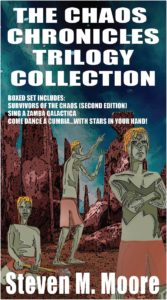Sci-fi reading and writing, part two…
[Note: This article is the second part of a three-part series on the topic of reading and writing sci-fi. In part one, I discussed my sci-fi blues. In this part, I’ll discuss some non-fiction sci-fi reading—is that possible? You can find out why I think the answer is yes in this article. In part three, I’ll talk about my solution to my sci-fi blues—writing a new sci-fi novel that’s also a rom-com.]
Asimov wrote the End of Eternity, so you might think Brian Greene’s lengthy tome Until the End of Time, is good sci-fi. (You can find my Bookpleasures review here: https://waa.ai/T7a8.) It’s not fiction, though, but it considers themes that we need to see more of in sci-fi today, where there’s a lack of good novels. And, like all good books, it left me thinking about what I’d read. There is a lot about mind in it—the Human mind. I write that with a capital H here (and in many of my sci-fi stories) to distinguish us from other intelligent species we might encounter if and when we leave Earth to explore the far reaches of our Universe, or if and when ETs come to visit us.
While author Greene has a similar scientific background to mine, he’s a bit myopic when it comes to mind. Better said, he’s anthropomorphic or Human-centered. In his defense, the Human mind is better known to him—he has a fine one of his own, after all. And he’s a fine writer, but he’s not a sci-fi writer. It’s not hard to imagine the powers of Darwinian evolution creating intelligent species where “mind” acquires a strange yet wonderful meaning.
The first sci-fi writer to do this, as far as I know, was Fred Hoyle, an astrophysicist (Greene and I were also trained as physicists) who wrote some good sci-fi. He’s been reviled and ridiculed for creating the steady-state theory of the Universe, but he also created the first example of a collective mind in his novel The Black Cloud, a classic sci-fi novel…and one of the best.
You see, the point Greene misses in his discussion of consciousness and self-awareness is the role complexity plays. No one believes a single computer can become self-aware, but a network of them could, and many computer science papers and sections of books have been written about how complex such a network has to be to become a conscious entity. Indeed, the Human brain is self-aware because it is so complex.
So, back to Hoyle’s Black Cloud. Like a computer network, it’s an intelligence spread over great distances and becomes self-aware because of its complexity. But we can go farther. Like what happens in even simple computer networks (consider the search for large prime numbers done via many networked computers), simple brains can join with others to make a huge collective intelligence where the whole is much greater than the sum of its parts.

Indeed, in Swarm (found in the second and third novels in The Chaos Chronicles Trilogy Collection), I’ve postulated just such a collective super-intelligence that’s a mental amalgam of billions of separate minds. The complexity is so great that poor Swarm goes a bit crazy at times (let’s call it that entropy disease), and another collective intelligence (planetary in this case), Singer, must step forward to serve as Swarm’s psychiatrist (the original title of novel #2 was going to be The Singer and the Swarm—I liked the alliteration—but that only hinted at part of the story). We can even inject such intelligences into a religious context, not in the sense that they’re like gods, but in the sense that they’re a concrete physical realization of “…the Buddhist dominion where the concept of distinct existence disappears”! (The words are Greene’s, written in his all-too-brief discussion comparing religions and how they came to be.)
But one can go even farther: Lets turn to fractals and self-similarity. The latter means that at each level of a fractal structure, it looks the same as each previous level. Now add communication links between levels. Both computer brains and brains from intelligent species could network in such a fractal manner. Now that’s real complexity!
Prigogine studied how complexity can naturally occur. (Greene mentions him in a different context, but I think Prigogine was a bit earlier than the fractal fad created by Mandelbrot using a lot of 19th century mathematics to create his mumbo-jumbo. I only attended one Mandelbrot lecture, which was enough for me—he holds the record for using the pronoun “I.”) It’s not hard to imagine such a structure extending to very complex minds. There’s nothing particularly religious about all this, but one can certainly see parallels with the “planes of existence” discussed in some religions (Buddhist and Hindu philosophies, for example).
Perhaps what’s more amazing and wonderful is that my pea-brain and others’ can imagine such things and put them in our stories. Greene makes a big deal about how storytelling evolved with us, or helped us evolve. Perhaps it’s still at work and good sci-fi books will entertain readers yet again! Sometime….
***
Comments are always welcome!
The Chaos Chronicles Trilogy Collection. Mr. Greene might be amused by the above. This trilogy also contains a superstring drive to provide the appearance of FTL travel, allowing one to jump between universes of the metaverse. And Humans first encounter with ETs is with intelligent beings they call Rangers who communicate by telling elaborate stories via spread spectrum signals. Those items might amuse Mr. Greene too. But this trilogy is really a bow to Isaac Asimov—it even has my version of the Mule in the third novel (no, it’s not Swarm). Available in .mobi (Kindle) ebook format at Amazon, and in all ebook formats at Smashwords and its affiliated retailers (iBooks, B&N, Kobo, etc.) and lending and library services (Scribd, Overdrive, Baker & Taylor, Gardners, etc.). Enjoy!
Around the world and to the stars! In libris libertas!
